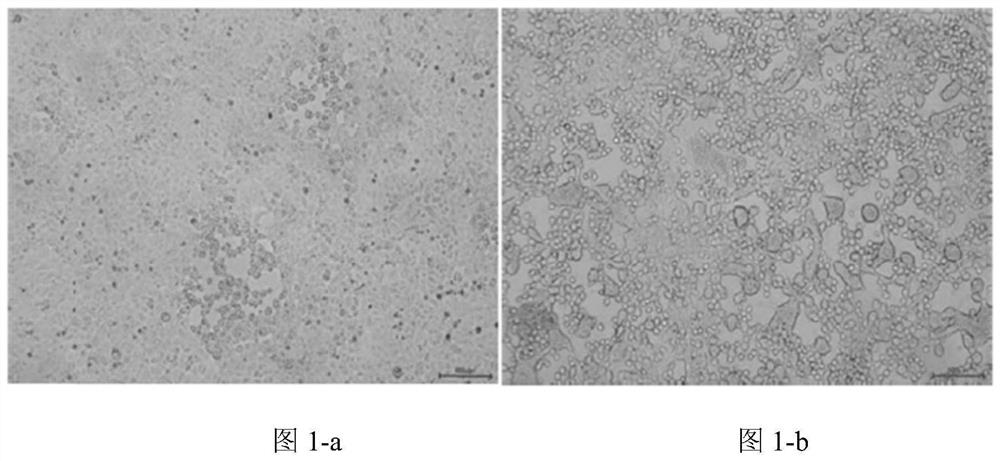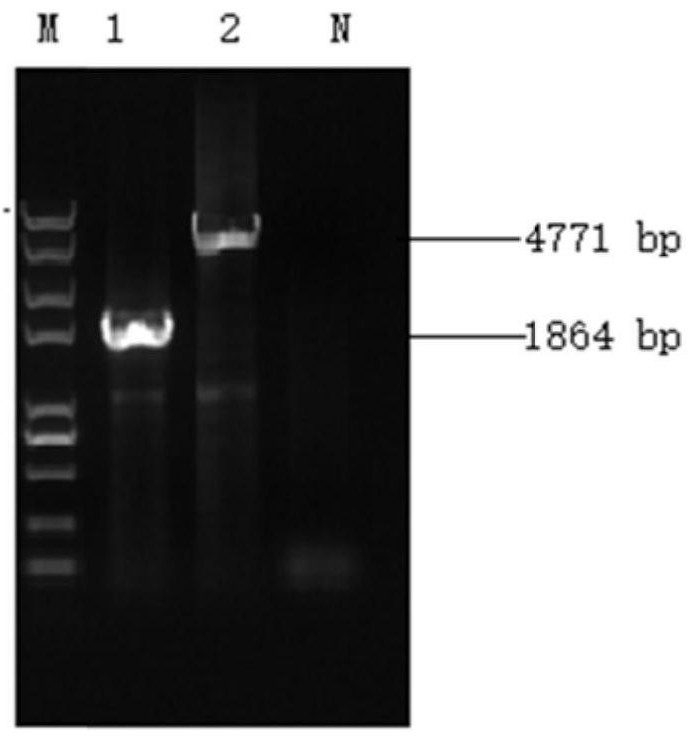Porcine pseudorabies variant virus strain and application thereof
A porcine pseudorabies virus strain technology, applied in the field of virus molecular biology and genetic engineering, can solve respiratory diseases, occasionally death, laboratory confirmed PRV wild virus infection, economic loss, breathing difficulties and other problems
- Summary
- Abstract
- Description
- Claims
- Application Information
AI Technical Summary
Problems solved by technology
Method used
Image
Examples
Embodiment 1
[0038] Example 1: Isolation and Identification of Pseudorabies Epidemic Variants and Virulent Strains
[0039] The aborted fetuses from a pig farm in Shandong were tested for porcine pseudorabies field virus antigen, and the result was positive for gE antigen. The supernatant of the positive disease material was inoculated into VERO cells for virus isolation, and a strain was isolated. Carry out gene identification and specific identification, it is found that the strain can be amplified to the corresponding PRV gene (NO.1~6), and the strain can be neutralized by pseudorabies virus-specific positive serum, identified as PRV virus, named It is PRV SD2020 strain.
[0040] PRV SD2020 strain induced VERO cell pathology such as figure 1 shown. figure 1 -a, figure 1 -b is the situation after 24h and 48h of inoculation with the PRV SD2020 strain, respectively, by figure 1 It can be seen that the PRV SD2020 strain specifically causes typical regular lesions (CPE) in infected cells...
Embodiment 2
[0045] Embodiment 2: Construction of porcine pseudorabies virus epidemic variant virulent strain genetically engineered strain (PRV SD2020ΔgI / gE strain)
[0046] Using CRISPR / CAS9 technology to knock out the gI / gE dual virulence gene on PRV, the specific process is outlined as follows:
[0047] 1. sgRNA sequence design and recombinant vector construction
[0048] Referring to the complete PRV genome sequence published in GenBank, the sgRNA sequences of gI and gE genes were designed and synthesized. The sgRNA sequences of gI and gE genes are shown in Table 2, and inserted into the BbsI restriction site of the psgRNA vector to construct the targeting plasmid.
[0049] Table 2 Design gI / gE sgRNA sequence
[0050] The PCR amplification product was identified by electrophoresis, and the electrophoresis results were as follows: figure 2 shown.
[0051] After the PRV SD2020ΔgI / gE strain was obtained, the gene sequence upstream and downstream of the gene deletion region was obtain...
Embodiment 3
[0054] Embodiment 3: Porcine pseudorabies virus epidemic variant virulent strain genetically engineered strain (PRV SD2020ΔgI / gE / TK strain) construction
[0055] Using CRISPR / CAS9 technology to knock out the gI / gE / TK three virulence genes on PRV, the specific process is outlined as follows:
[0056] Similarly, with reference to the process of Example 2, the TK gene target site was further designed (see Table 3 for the TK gene sgRNA sequence), the recombinant vector was constructed, transfected, and the plasmid and the viral genome were homologously recombined, and then purified by plaque to obtain The PRV SD2020ΔgI / gE / TK strain lacking gI, gE, and TK genes was identified.
[0057] Table 3 TK gene sgRNA sequence
[0058]
[0059] The results of PCR identification of the virus strains were as follows: Figure 5 As shown, the sequenced TK sequence is shown in SEQ ID NO.8, the electropherogram file
[0060]
[0061] 2. Transfection
[0062] The targeting plasmid was tran...
PUM
 Login to View More
Login to View More Abstract
Description
Claims
Application Information
 Login to View More
Login to View More - R&D
- Intellectual Property
- Life Sciences
- Materials
- Tech Scout
- Unparalleled Data Quality
- Higher Quality Content
- 60% Fewer Hallucinations
Browse by: Latest US Patents, China's latest patents, Technical Efficacy Thesaurus, Application Domain, Technology Topic, Popular Technical Reports.
© 2025 PatSnap. All rights reserved.Legal|Privacy policy|Modern Slavery Act Transparency Statement|Sitemap|About US| Contact US: help@patsnap.com



